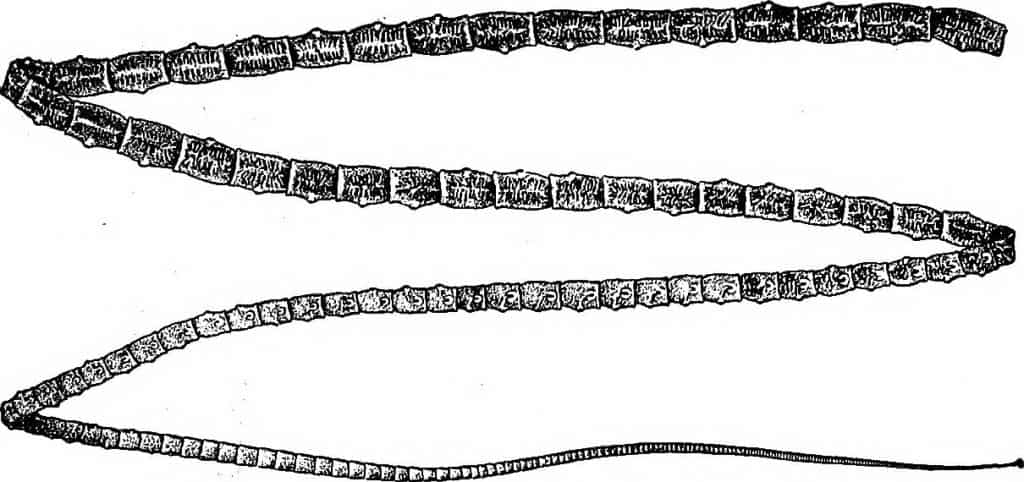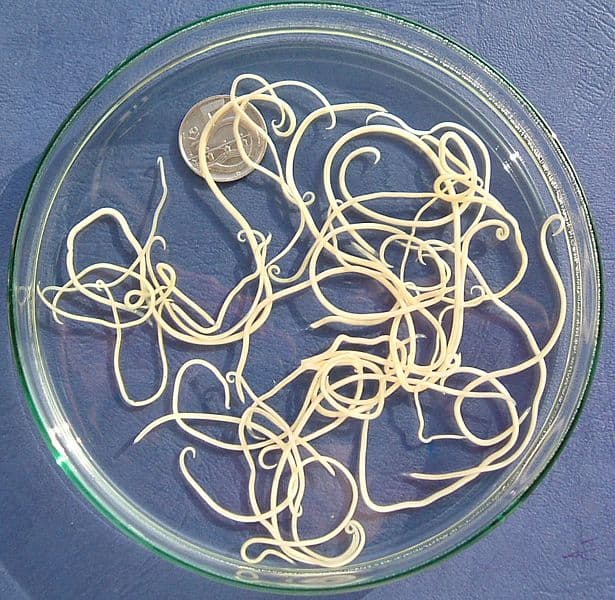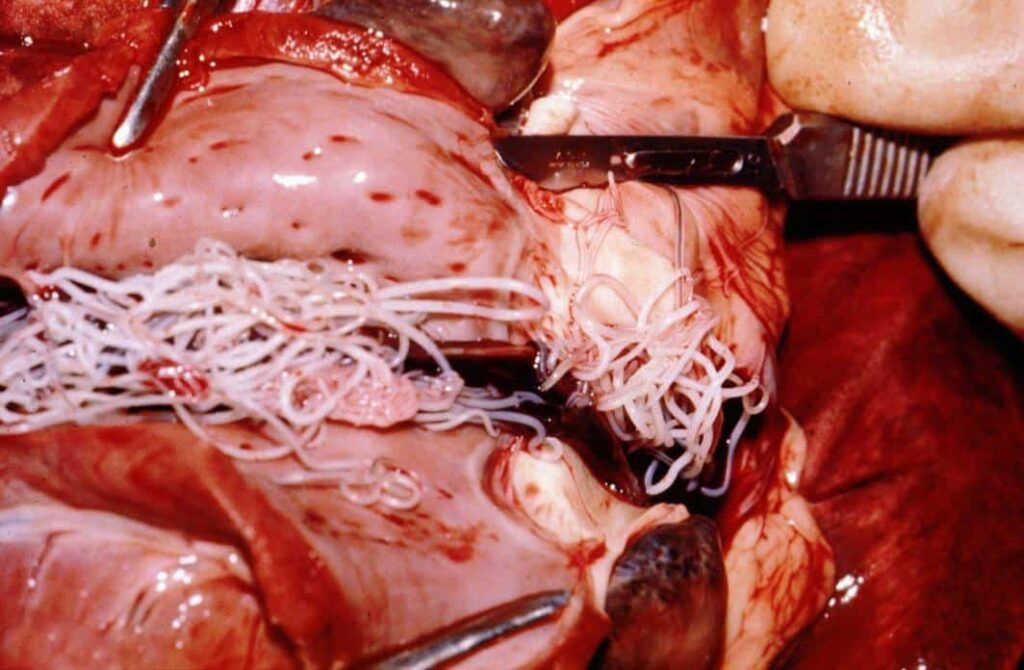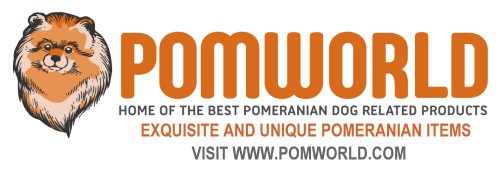Last Updated on 26/02/2022 by Dochlaggie. Post first published on July 18, 2016.
There are a number of different common worms in dogs. It’s essential that you know details of all worms found in dogs so you can safely protect the health your Pomeranian dog.
This page will answer your questions about worms found in dogs:
- How can you tell if your dog has worms?
- Symptoms of worms.
- How to treat tapeworms in dogs.
- Roundworm treatment for dogs.
- How to get rid of tapeworms in dogs
- What to give dogs for worms.
- How to treat worms in dogs.
- Common worms in dogs.
- How do you know if your puppy has worms?
TAPEWORMS

Tapeworms are flat and have parts that spread across your Pom’s body. The head has muscular grooves or suckers that let the worm to connect to the intestines of your canine friend. A mature tapeworm growing in your dog may be up to 50 cms in length.
It remains alive because it sucks the nutrients out of your Pom’s through his skin. In puppies, tapeworms can cause anaemia, inhibit growth and cause blockages in the intestines.
How Can Tapeworms Live in Dogs?
These are usually worms from fleas. The most common method for getting tapeworms is by swallowing one or more fleas because they have tapeworm eggs. A less common method is coming into close proximity with lizards and/or rodents that have tapeworms.
Signs of Tapeworms in Dogs. Tapeworm Symptoms in Dogs
These dog worms look like rice. Dried parts of tapeworms may be around the anus of your Pomeranian and are usually about the size of a single rice grain. They cause itchiness and your dog may move drag his butt on the ground to get rid of the itchy feeling. Tapeworms in dog poop, if your look whole worms can often be seen in your dog’s droppings.
How to Get Rid of Tapeworms in Dogs
If you think your dog may does have tapeworms, ring and talk to your vet who may ask you to see him so he can examine a fresh stool sample. Once diagnosed, he can be prescribed with oral tapeworm treatment for dogs to remedy the problem.
Tapeworm Treatment for Dogs

HOOKWORMS IN DOGS
These worms are incredibly nasty. The worm bites and clamps down on your Pomeranian’s intestine and makes a hole within a blood vessel. Then your dog’s blood will slowly be drained. If your Pom had around 300 hookworms, 5%- to 10% of his total supply of blood EVERY day! Treatment must start urgently or hookworms may be fatal if not caught early enough.
How Do Dogs Contract Hookworms?
Hookworms may exist on your Pomeranian for one of three reasons. Hookworms may exist from the moment a puppy is born. Puppies may attract hookworms while drinking his mother’s milk. The final cause is that a Pomeranian could swallow hookworm larvae. They’re microscopically small and may exist on grass blades, in dog bowls for food and many other places.
Symptoms of Hookworms in Dogs
After your Pomeranian is infected by these nasty worms, symptoms may appear but they can also copy other medical problems. Examples include: diarrhoea (generally bloody or black in colour, loss of appetite, vomiting, weakness, slowed growth, emaciation and his mouth may have mucous membranes that are pale and clouded.
Hookworm Prevention
There are a couple of ways you can prevent your Pom from getting hookworms.
- Hygiene is a crucial factor in preventing hookworms. Never leave his faeces in your yard.
- People need to wash their hands regularly, especially if playing with pets and then doing other things. Ensure your pet is clean and regularly groomed.
- Hookworms can travel from dog to dog to environment and then to another dog. Because of this, avoid parks that aren’t clean
- If you feed food you have made yourself, cook the meat really well.
- When you clean your home’s hard surfaces, use bleach as this destroys the larvae of the hookworms.
- The single most vital method for protecting your Pom from hookworms is to have regular vet check-ups. This is in addition to getting help for any health issues that can occur at any time. Your vet can treat hookworms easily once it’s correctly diagnosed.
How to Treat Hookworms in Dogs:
Any of the medications listed below will remove hook worms in puppies and dogs:

ROUNDWORMS IN DOGS

The most common type of parasite that occurs in dogs is roundworms. They’re four inches in length and looked like strands of cooked spaghetti, being a white colour. Roundworms exist in a dog’s intestine, where they remain alive by eating food that hasn’t been fully digested.
Causes of Roundworms
Puppies and worms are common. If a dam has roundworms, they may be passed onto their puppies who are born with this type of worm. A puppy may also get roundworms from drinking his mother’s milk.
The mother may not be diagnosed for roundworms but can still pass it onto her newly born puppies. This is because she could have undeveloped larvae. Dogs may swallow these worms if they’re chewing on rodents and consuming soil containing the worms.
How Do You Know If Your Puppy Has Worms?
There are usually no visible symptoms of roundworms in the initial stages. So it’s critical that you have a regular de-worming action plan. Your vet will give you a plan to which you must adhere. If your Pomeranian is hit with roundworms, he may vomit.
When doing so, you’ll notice roundworms because they’re round instead of, like the tapeworms, segmented. His stomach may be swollen, he may have pneumonia and, as the worms move through his body, some symptoms can vary in intensity.
Prevention of Roundworms
Regular check-ups should be top of the list. If your Pom starts chewing on rodents, soil or carpet rugs will help blocking roundworms from entering your dog’s body.
Roundworm Treatment for Dogs
Medication can kill worms. It forces the worms to release their grip and then they get pushed down and then expelled from the dog’s body during bowel movements. There are multiple methods to kill the parasites.

HEARTWORMS

Heartworms are of similar sizes to tapeworms and roundworms. However, heartworms can kill dogs if untreated soon enough. This worm resides in the right ventricle of a Pomeranian’s heart as well as blood vessels nearby. An infected mosquito may bite a dog and that causes the dog to become infected himself.
It’s astonishing that the tiny mosquito can have a powerful impact on your Pomeranian. The larvae enter the dog’s body and begins to grow. It takes approx. three months for heartworms to get into the heart, where it’s time to roam. He’ll grow up to about 14 inches and within six months, the females will be ready to reproduce more of these worms.
Heartworm Symptoms in Dogs
It’s often too late for treatment by the time the dog has seen the vet, and received the analysis of your own situation.
Early heartworm symptoms in dogs may occur sometimes and they include:
- Weakness.
- Fatigue.
- Coughing.
- Loss of weight.
- Breathing is difficult.
- Vomiting.
Later Stages Heartworm Symptoms in Dogs Include:
- Fainting.
- Trouble coping with exercises such as walking, etc.
Heartworm Prevention is Critical
Heartworm medication is the way to treat heartworms if diagnosed early enough. If not, death may be the inevitable result. Talk to your veterinarian about your concerns. For complete details on the safety of most dog heartworm prevention medication and best and safest heartworm prevention medicine for Pomeranians CLICK HERE:
How To Get Rid of Heartworms in Dogs
If your Pomeranian dog is badly infected by heartworms, the treatment isn’t easy. The medication used to kill mature heartworms is usually arsenic-based. Your Pom needs to be watched by your vet for a few days to ensure there are no unforeseen problems.
While your pet’s body expels heart; worms via his stools, some may cause blood vessel blockages that may create a pulmonary embolism. This can prove fatal if not treated immediately. If you want to increase the possibility of your four legged family member surviving, he needs to be very quiet and calm for a whole month after the treatment.
As a last resort, the worms may be removed surgically but, sadly, not all procedures have a happy ending and in many cases, your Pomeranian dog may have to be put to sleep so he doesn’t suffer.
Ringworm in Dogs
Despite the name, the ringworm isn’t a worm at all. Its name is Dermaphtytes, which is a fungus. The name literally means “‘plants that live on the skin.”
Previously, ringworms were regarded as worms due to lesions on the skin that are circular in shape. The fungi exists on your Pomeranian’s skin surface and follicles and it retains its life by consuming fur and dead tissues. There are three fungi types that may cause ringworm. However, the dominant one on dogs is named Microsporum canis.
How is Ringworm Spread?
Ringworms are spread from a different infected animal or even a human. It can move back and forth between dogs and cats in the same way that it can move from dogs, to and from, people. It’s highly contagious and you and your pet can have it or infect the other creature” with it.
It can be spread during grooming and petting of the dogs and it’s also spread by cows, horses, pigs, goats and cats. The spores from this fungus may live in the right environment for days, weeks, months and even after all this, even years. Ringworms can be contracted and spread by your pet’s bedding, carpets and grooming tools.
The necessary incubation period runs from 10-12 days. So you won’t see any issues unless you check yourself first and then after the incubating period, lesions may appear. You may get infected if you’re touching soil that’s already infected. If there are enough nutrients in the soil, the fungus may thrive for months.
However, a dog ringworm treatment home remedy is to kill the spores is with by mixing 500 ml of bleach and four litres of water.
Do All Dogs Have the Same Risk Of Getting Ringworm?
Dogs who are very healthy overall often are resistant to ringworm. young dogs and Puppies are in a higher risk category because they have a weak immune system. Many carriers exhibit no visible symptoms but can still infect people and animals
Ringworm Symptoms in Dogs
The main signs of ringworm in dogs are on the coat and skin is a lesion beneath the skin where the ringworm sits. It also means your pet may be balding in areas where ringworms have connected. Your dog’s belly is a place where ringworms and the ensuing lesions can be visible.
People have a red, circular ring inside the circular lesion itself. The lesion will grow and may develop in odd shapes. Hair shafts get broken off and, that’s why you have patches of fur that are almost gone.
Popular ringworm places on your dog’s body include: paws, tail, belly, ears and face. These lesions are scaly and may get itchy and cause a swelling and reddish tinge.
Ringworms in Dogs Diagnosis
It’s impossible to diagnose ringworms simply by looking at your dog. Tests will need to be carried out by your vet. Treatment. If you don’t do anything to treat your pet, the disease will usually fix itself in 2 to 4 months and the symptoms will also settle.
However, most people prefer to take better care of their pets. This is also vital because your dog could be contagious as well and the risks of infecting others increases.
Ringworm Treatment for Dogs
Taking anti-fungal drugs BUT there’s also a risk for the animals because they may have horrible side effects. Only try medications prescribed by your vet. Dips and shampoos. Lime sulphur dips can be useful and should only be carried out by your vet or doing it yourself but be wary of the risks.
Lime sulphur has a powerful smell, can cause your dog’s coat to have areas of yellow (temporarily) and can also stain your clothing so protect yourself as much as possible when doing it.
Antifungal Cream for Dogs Ringworm

De-worming of Puppies
It’s necessary to create a deworming schedule so you can mark off the days to do it. Your puppy must be dewormed when he’s two, four, six and 8 weeks old and then at 3 months and four months of age.
Disclaimer: The Content is not intended to be a substitute for professional veterinarian advice, diagnosis, or treatment. Always seek the advice of your veterinarian with any questions you may have regarding the medical condition of your dog. Never disregard professional advice or delay in seeking it because of something you have read on ANY website.
Heartworm Photo by By Alan R Walker (Own work) [CC BY-SA 3.0 (http://creativecommons.org/licenses/by-sa/3.0)], via Wikimedia Commons.
Copyright Pomeranian.Org. All Rights Reserved.
References and Further Reading:
[1] Denise Leo “The Pomeranian Handbook”.
What to Give Dogs For Worms









